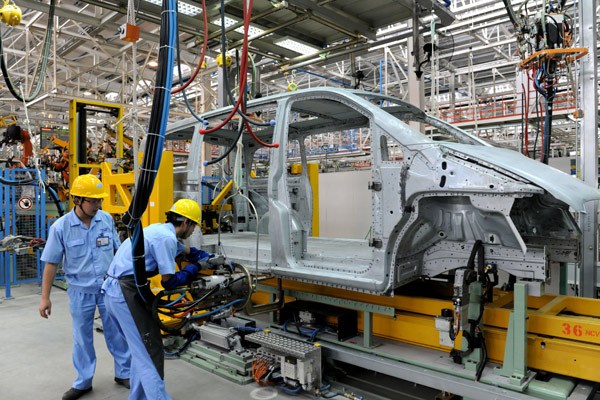Quietly But Successfully, US Companies Are Buying Chinese Businesses
–
–
Is China really buying up America? Or is it the opposite?
Chinese investments in the US draw lots of headlines and occasional handwringing about China’s growing influence and ownership. It is true that Chinese investors, especially SOE, have been throwing billions of dollars around, mostly for US real estate.
Far more quietly, and perhaps with better overall results, US investors have been buying businesses in China. The US acquirers do their utmost to stay out of the headlines. They prefer to shop quietly, without competitors finding out. This does a lot to keep prices down and give these US buyers maximum negotiating leverage. A lot of these US acquisitions in China stay secret long after they close.
Contrast this style with that of Chinese investors in the US. Most end up bidding against one another for the same assets. Overpaying has become a hallmark of Chinese purchases in the US.
Compared to the huge number of Chinese companies shopping for assets in the US, not nearly as many US companies are sizing up deals and kicking tires in China. Partly this stems from some misunderstandings among less-experienced US acquirers about what kinds of Chinese businesses can be targeted. Topping the list of sweeping generalizations: Chinese companies, especially privately-owned ones, are said to have owners who rarely wish to sell. Those that do, want to sell their deeply troubled companies at Neiman Marcus prices.
There is some truth to this arm-chair analysis. But, equally, there are good deals being done. I’ve written before about the most successful US acquisition in China, by food giant General Mills. (Click here to read.) It’s a textbook case of how to do M&A in China and also how to build a billion dollar business there without anyone really noticing.
Why buy rather than build in China? For one thing, China has huge and fast-growing markets in almost all industries except the smoke-stack ones. For buyers that choose and execute well, the China market is proving lucrative ground to do M&A. It’s a truth that remains a known to a select group of smart buyers.
Lifting the veil a bit, here are some of the largely-unpublicized acquisitions done by smart American buyers in China.
In April 2015, 3D Systems, a New York Stock Exchange-quoted manufacturer of 3D printers, purchased 65% of a Chinese 3D printing sales and service company Wuxi Easyway. The Chinese company’s customers in China include VW, Nissan, Philips, Omron, Black & Decker, Panasonic and Honeywell. 3D Systems has an option to purchase the remainder of the business within five years.
Along with acquiring a developed sales network and increased distribution in China, another key aspect of the deal was to make the founder of Easyway, a Western-educated Chinese, the CEO of a newly-formed subsidiary, 3D Systems China. The plan is to make the Chinese founder the king of a larger kingdom, a carrot frequently dangled by American companies to persuade Chinese founders to sell to them.
Since the deal closed, 3D Systems also accelerated the build-out of its operational infrastructure in China. What lies behind the deal? 3D Systems acquired a local management team as well sales channels, customer relationships. It did not acquire manufacturing capability.
3D Systems manufactures high-quality 3D printers that sells at significantly higher prices than Chinese domestic competitors. Owning a Chinese business with established customer relationships in China will make it easier for 3D Systems to penetrate more deeply what should become the world’s largest market for 3D printers. The shift is particularly strong among Chinese private sector manufacturing companies making products for China’s consumer market.
Prior to the acquisition, Easyway was not a major client or partner of 3D Systems. As the integration moves forward, Easyway will likely expand its product offerings in China beyond relatively commoditized business of producing 3D prototypes. 3D Systems’ printers have broader capabilities, including the production of end-use parts, molds for advanced tool production, medical and surgical supplies.
The dual-track strategy is for Easyway to maintain its existing comparatively low-end service business in China while adding two new sources of revenue: the sale of 3D Systems’ 3D printers in China and an enhanced/upgraded service business of using 3D Systems printers to produce higher-quality and more complex parts to order for Chinese customers. Both should positively impact 3D Systems’ P&L.
3D Systems used a deal structure that often works well in China. They bought a majority of Easyway, while leaving the target company founder/owner with a 35% minority stake in an illiquid subsidiary of 3D Systems. 3D Systems has the option to buy out the remaining shares and assume 100% control. But, the option may never be exercised. 3D Systems now enjoys the benefits of holding corporate control, including consolidation, while also keeping the previous owner aligned and incentivized.
The deal isn’t without its risks, of course. 3D Systems previously had no corporate presence in China. It therefore did not have its own management team in place and on-the-ground in China to manage the integration of Easyway and monitor the business going forward.
In July 2013, Illinois Tool Works (“ITWâ€), a huge and hugely-successful US industrial conglomerate, purchased 100% of a Chinese kitchen supply manufacturer Gold Pattern Holdings, based in Guangzhou, from global private equity firm Actis.
The acquisition fits well with the expansion strategy of ITW of looking to make tuck-in acquisitions in their core business segments. ITW has a large food equipment business with over $2 billion in annual revenue, 15% of ITW’s total. Gold Pattern’s business is selling Western-style kitchen equipment to restaurants and hotels in China.
From discussions we’ve had with ITW since the acquisition, the deal is considered a solid success within ITW. The company says it has a strengthened appetite to make more such acquisitions in China, a key market for the company going forward.
ITW owns some of the most well-known brands in the food equipment industry, including Hobart mixers and Vulcan ranges. Buying Gold Pattern was part of a strategy to increase sales and distribution of these ITW brands in the fast-growing China market. Gold Pattern’s own commercial kitchen equipment is lower-priced and generally considered lower-quality. But, the domestic sales channels used to sell Gold Pattern’s equipment is also suitable to distribute ITW’s US brands.
ITW expects that as China continues to grow more affluent, the demand among the Chinese middle class for European and American food will expand significantly. This will create a long-term market opportunity for ITW to sell Western style commercial kitchen equipment. More and more four-and-five star hotels in China are being equipped with Western kitchens as well as Chinese ones.
ITW mitigated its deal risk by buying Gold Pattern from a well-regarded international PE fund. As a result, Gold Pattern already had fully-compliant GAAP accounting, established corporate governance structures, and a professional management team. No less important, ITW knew from the outset that Gold Pattern had already successfully undergone the forensic due diligence process that preceded Actis buying control of the company. This significantly lower due diligence risk, a prime reason many deals in China – both minority and control – fail to close.
ITW has significant experience buying and integrating businesses globally. They had operations in China for twenty years prior to this acquisition. ITW and another diversified Midwestern industrial company, Dover Corporation, are both actively, but ever-so-quietly seeking more acquisitions in China, aimed primarily at expanding their sales and distribution in China’s growing domestic market.
This deal happened a long time ago, but continues to pay dividends for Amazon. In August 2004, they bought 100% of Chinese e-commerce company Joyo, paying a total of $75mn including an earn-out. At the time, e-commerce in China was in its infancy, while Amazon was less than one-tenth its current size. The purchase of Joyo was a calculated gamble that China’s online shopping industry, despite huge impediments at the time including no established online payment systems would eventually achieve meaningful scale.
The gamble has paid off handsomely for Amazon. The e-commerce industry in China is now at least 50X larger than in 2004, with revenues last year of over $700bn. E-commerce revenues are projected to double in China by 2020. Amazon is the only non-Chinese company with meaningful market share and revenues in this hot sector. That said, Amazon is dwarfed by Alibaba’s Taobao, which has a market share in China estimated at 75%.
But, Amazon in 2012 spotted an opportunity to use its China-based business to establish a highly-lucrative cross-border business facilitating direct export sales by Chinese manufacturers and individual traders on Amazon’s main US and UK websites. This is a business Alibaba has tried and so far failed to enter. As a result, Amazon’s senior management, if they know no one is listening, will tell you the Joyo acquisition is a big success. It generates meaningful revenue in China (approx. $3bn), while supporting the infrastructure to build out the cross-border exports. Amazon continues to invest aggressively in China, with enormous warehouse facilities (800,000 total sqm) and wholly-owned logistics business.
When Amazon bought Joyo, it knew full well that Chinese law, as written, forbids foreign companies from owning a domestic internet company. The Chinese government views the internet and e-commerce as “strategic national industriesâ€. At the time, Amazon got around this by using an ownership structure for its China business called a “Variable Interest Entity†(“VIEâ€) also used by some domestic Chinese e-commerce companies that listed on the US stock market. The Chinese government, if they chose to, could probably shut Amazon down in China, because it’s using this loophole to operate in China. That could leave Amazon scrambling to find a way to stay in business in a country in which it now has hundreds of millions of dollars in assets.
The boards of many other large US companies would blanch at approving a deal where the assets are owned indirectly and control could be so easily forfeited by Chinese regulatory action. But, Amazon, with founder Jeff Bezos firmly in control, has shown itself time and again to be comfortable with making rather bold bets. Success in China often requires that mindset.
Of course, US buyers have also slipped on their share of Chinese banana peels. Three well-known Silicon Valley technology companies tried and mainly failed to do M&A successfully in China. All three followed a similar strategy to acquire domestic Chinese technology companies started and owned by Chinese who had previously studied and worked in the tech field in the US. The acquisitions followed the general strategic logic of most tech M&A within the US: to identify and acquire companies with complimentary proprietary IP. But, the results in China fell well short of expectations.
The three deals were:
- Cirrus Logic acquired Caretta Integrated Circuits in 2007. By 2008, the acquired company was shut down and Cirrus recorded a $12mn loss.
- Netgear acquired CP Secure in 2008. There is now no trace of the original CP Secure business, nor any indication it is ongoing concern.
- Aruba Networks acquired Azalea Networks in 2010, a Chinese wireless LAN provider.
Over the last five years, no similar M&A deals in China were announced by larger Silicon Valley companies. The strategy has shifted from acquiring companies for their IP to targeting companies for their domestic Chinese distribution and sales channels. This reflects the fact that indigenous innovation in China has not made much of a global impact. IP protection in China is still inadequate by US standards. China is also a late adopter market, which further impedes the development of globally-competitive domestic technology companies.
The successful US acquisitions in China were all rooted in a different, more viable strategy: to buy one’s way directly or indirectly into China’s burgeoning consumer market.
Abridged version as published in Nikkei Asian Review
–
–






































